TOPKAPI'S MUMMIFIED CROCODILE BOY AND AMERICA'S MONKEYFIED ALLIGATOR MEN - A CURIOUS QUARTET OF GENUINE FAKES!
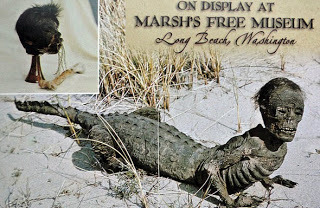 Postcard depicting Jake the Alligator Man (© Marsh's Free Museum)
Postcard depicting Jake the Alligator Man (© Marsh's Free Museum)On 1 March 1992, Turkish archaeologists publicly announced the discovery of an extraordinary Egyptian mummy in the vaults of Istanbul's famous Topkapi Palace Museum during some recent restoration work there. It was concealed inside a wooden sarcophagus (whose form confirmed it as having originated in ancient Egypt), and when carefully unwrapped it was found to consist of the upper parts of a young boy fused to the lower half of a crocodile!
The explanation for this bizarre specimen is still unknown. Some researchers have speculated that the boy may have been killed and partially eaten by the crocodile while bathing (or after accidentally falling) in Egypt's Nile River – and that in order for him to possess a complete body with which to pass into the afterlife, his parents arranged for his reptilian murderer to be killed and for the section of its body corresponding to the devoured portion of their son's to be attached to the boy's remains. However, this theory seems no less grotesque than the mummy itself!
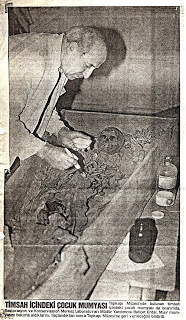 Photocopy of a photograph - click to enlarge - depicting Topkapi's mummified crocodile boy being examined by the museum's Assistant Director of Restoration and Conservation, Behçet Erdal – from a report dated 1 March 1992 in the Turkish newspaper Meydan(© Meydan – photocopy courtesy of Paul Sieveking/Fortean Times via Izzet Goksu)
Photocopy of a photograph - click to enlarge - depicting Topkapi's mummified crocodile boy being examined by the museum's Assistant Director of Restoration and Conservation, Behçet Erdal – from a report dated 1 March 1992 in the Turkish newspaper Meydan(© Meydan – photocopy courtesy of Paul Sieveking/Fortean Times via Izzet Goksu)A more plausible possibility is that the pseudo-conjoined mummy was deliberately created as a sacred artefact or offering by worshippers of Sebek (aka Sobek), ancient Egypt's crocodile-headed god of rivers and lakes. It may even have been produced as a clever fraud for exhibition purposes – in modern times, such specimens are popularly referred to as gaffs; if so, this would make it one of the earliest gaffs ever recorded.
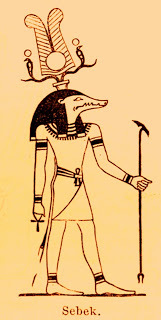 Line drawing from 1885 of Sebek, ancient Egypt's crocodile-headed deity (public domain)
Line drawing from 1885 of Sebek, ancient Egypt's crocodile-headed deity (public domain)As yet, I have not succeeded in discovering whether this unique specimen is on public display at Topkapi. So if anyone reading this ShukerNature blog article can provide me with some relevant details, I'd be very grateful.
Similar monstrosities were once very popular in carnivals and sideshows, especially in America, and at least one such creation still is today. Known as Jake the Alligator Man and constituting the upper half of a monkey skeleton skilfully attached to the lower half of a small alligator, this famous specimen has been on display for many years at Marsh's Free Museum [http://www.marshsfreemuseum.com/] – a thoroughly fascinating, highly-recommended exhibition of wonders and curiosities in Long Beach, Washington (not California, as often erroneously claimed) – and is said to be more than 75 years old.
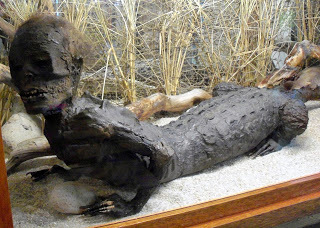 Jake the Alligator Man (© imhavingfun42/Wikipedia)
Jake the Alligator Man (© imhavingfun42/Wikipedia)Indeed, every year for almost a decade now there has been an official Annual Jake the Alligator Man 75th Birthday Party held in Long Beach. A short YouTube video of Jake on display at Marsh's Free Museum can be viewed here .
Incidentally, a much more common variant on this particular gaff theme is of course the so-called 'Feejee mermaid' (named after the famous specimen exhibited by American circus showman Phineas T. Barnum in 1842), which consists of the upper half of a monkey sewn to the lower half of a large fish.
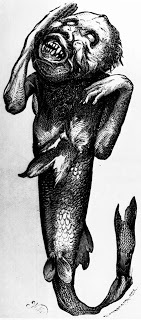 19th-Century engraving of Barnum's Feejee mermaid (public domain)
19th-Century engraving of Barnum's Feejee mermaid (public domain)Jake was purchased by the founders of Marsh's Free Museum in 1967 from an antique store in California, for the princely sum of $750, and was allegedly created by a New York-based firm known as Nelson Supply House. Jake subsequently featured in a series of highly entertaining albeit fictitious reports published by the American tabloid Weekly World News and beginning on 9 November 1993, which claimed that it had been found alive in a Florida swamp!
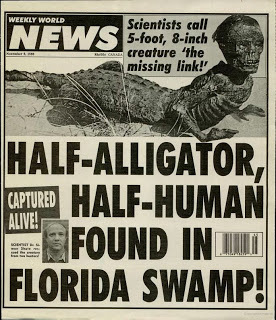 The headline from the first in the series of Jake the Alligator Man reports from Weekly World News (© Weekly World News)
The headline from the first in the series of Jake the Alligator Man reports from Weekly World News (© Weekly World News)More recently, a man named Josh brought a similar gaff into the curiosities shop Obscura featured in the Science Channel TV show Oddities, and sold it to the shop's proprietors for $450. A YouTube video of this interesting episode, uploaded by Science Channel on 1 June 2011 and showing the gaff in close-up detail, can be viewed here .
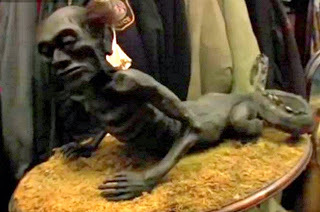 The Oddities alligator man (© Science Channel)
The Oddities alligator man (© Science Channel)I also know of a third American alligator man specimen, but, sadly, its present whereabouts are apparently unknown (or at least to me). I have on file a copy of a report from 1996 written by Chris L. Murphy from the organisation Progressive Research, based in British Columbia, Canada. In his report, Chris documented his recollections of what appears to have been an outstanding alligator man, which he encountered while visiting the little town of Seaside, in Oregon, during the summer of 1976. Going into a large general store in the centre of the town, he discovered that it contained a free museum, and exhibited in that museum, housed inside a glass case, was a remarkable specimen labelled as an Alligator Boy. In his report, Chris described it as follows:
"The creature in the case was human looking to about its navel, and the rest of its body was that of an alligator. The human part was "upright," fairly erect as I recall. I studied the creature for a long time and reasoned that it was the body of a child, say about two years old, that had been fused onto the body of a small alligator. The child's body was "mummy-like" in appearance but still had considerable detail. I recall especially its hair, which was very fine and white, very much like the hair one would find on a child of this age, except for the color.
"The process used to fuse the bodies was certainly very exacting. The smooth skin of the child melded in with the scaly alligator skin very gradually, making the creature appear very realistic. I carefully studied the head, hands (which were very small), arms and other parts of the body and reasoned that it would be very difficult to fake something of that nature. In other words, I believe the human portion of the creature was the body of a real child. Unfortunately, there was no literature on the exhibit, and I did not take a photograph of it."
Chris revisited Seaside in or around 1993, intending to photograph the alligator boy, but when he arrived in town he discovered that the general store and its in-house museum were gone, replaced by a clothing store. When Chris spoke to a couple concerning the store and its alligator boy, the man informed him that he'd lived in Seaside most of his life and remembered this specimen well, but stated that some time before the store had closed down, it had been robbed and the alligator boy stolen from it.
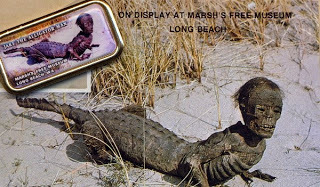 A second postcard depicting Jake the Alligator Man (© Marsh's Free Museum)
A second postcard depicting Jake the Alligator Man (© Marsh's Free Museum)Another Seaside resident, the proprietor of a jewellery store there, informed Chris that there was an alligator man on display at a free museum in Long Beach, Washington (Jake the Alligator Man at Marsh's Free Museum, obviously) and wondered whether this could be the same specimen as the one that had vanished from Seaside's erstwhile store-museum. Anxious to pursue this potential lead, on his way back home to British Columbia Chris stopped by in Long Beach and visited its alligator man. However, he could see straight away that this was a totally different specimen, its body held at an angle, not erect, and, at least in Chris's opinion, of inferior workmanship to the Seaside specimen that he had seen back in 1976. Moreover, he was able to chat with the museum's owner in Long Beach, who confirmed that he had purchased Jake in California (and a decade before Chris had seen the Seaside specimen anyway), and was unaware of any comparable gaffs anywhere else.
Having not seen the Seaside specimen personally, I am reluctant to discount Chris's opinion that it incorporated the head and upper body portion of a real human child, but it does seem more likely that these constituents of this gaff were actually derived from a monkey. Having said that, however, gaffs can be inordinately sturdy (especially if well-constructed), and hence are sometimes extremely old – dating back to times when, whereas albeit entirely abhorrent today, the prospect of such a macabre exhibit having been purposefully created would have been neither unthinkable nor impossible, as exemplified by Topkapi's mummified crocodile boy.
Meanwhile: whatever happened to the Seaside alligator boy? (Not only is it not Jake the Alligator Man, it is not the specimen sold on Oddities either, because the latter's body was not erect in posture but instead was held at an angle, just like Jake's.) Does it still exist today, and, if so, where is it? And are there still other alligator man gaffs also out there? If you know of any, or have any information concerning the presently lost Seaside specimen, please post details here on ShukerNature – thanks again!
 Two Turkish newspaper reports from 1 March 1992 - click to enlarge - concerning the Topkapi mummified crocodile boy, one from Meydan, the other from Hürriyet (© Meydan/(© Hürriyet - photocopies courtesy of Paul Sieveking/Fortean Times via Izzet Goksu)
Two Turkish newspaper reports from 1 March 1992 - click to enlarge - concerning the Topkapi mummified crocodile boy, one from Meydan, the other from Hürriyet (© Meydan/(© Hürriyet - photocopies courtesy of Paul Sieveking/Fortean Times via Izzet Goksu)This ShukerNature blog article is a greatly-expanded, fully-updated version of a short account of mine that originally appeared in my book The Unexplained: An Illustrated Guide to the World's Natural and Paranormal Mysteries (1996).

Published on May 23, 2015 11:28
No comments have been added yet.
Karl Shuker's Blog
- Karl Shuker's profile
- 45 followers
Karl Shuker isn't a Goodreads Author
(yet),
but they
do have a blog,
so here are some recent posts imported from
their feed.



